|

The Mulch
Gone to Pot…
In the last edition, I promised to report back on the great North Wales Christmas Potato Experiment. Well, it’s 1 – 0 to Y Felinheli as Kim and Martin’s crop outnumbered mine by several tubers to one!
Whilst I had harvested some for Christmas, the small size and meagre numbers didn’t warrant the effort to cook them. It’s probably just too cool to risk this at my elevation, despite the warm autumn we had.
Take a look at Kim’s bumper crop (below left) and mine to the right. Our properties are only about 20 miles apart, but Kim and Martin’s garden is almost at sea level and mine is at 600ft (190m).
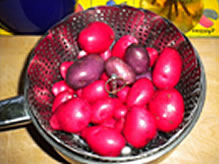 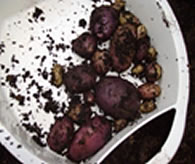
< A Tale of
Two Chittings
Same chatted potato tubers, same growing period, different elevation and temperatures
Shady Characters…
Geranium phaeum, also known as Dusky Cranesbill, is coming into flower now. This striking plant sends up its purply-black flowers on tall stems that can reach 60cm / 2ft.
It’s also called ‘Mourning Widow’, possibly due to its deep and sombre colouring. The leaves are marked with purply-brown blotches in a fan-shaped pattern.
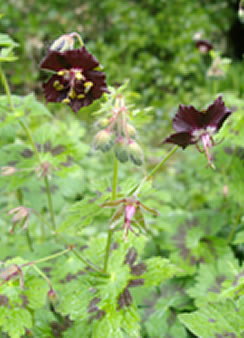 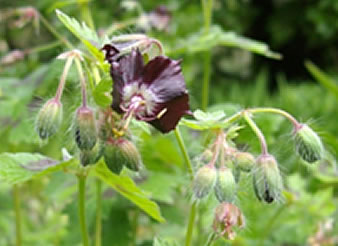
< ^ Mourning Glory
This dramatic Geranium comes into its own during late March and early May
Ideal in shady, damp spaces, it looks amazing grown among a clump of limey green, carpet-forming perennials, including Yellow Archangel (Lamium galeobdolon), Sweet Woodruff (Galium odoratum), Golden-leaved Saxifrage (Chrysosplenium oppositoides) and Wild Strawberry (Fragaria vesca). The limey-green foliage sets off the dark flowers of the Geranium beautifully and the gangly stems propel the flowers high above the understorey to sway gently in the breeze.
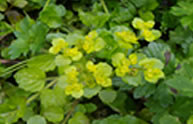 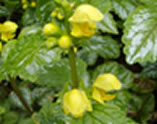 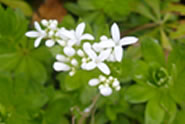
^ Deep Impact
Low growing, shade loving perennials such as Golden-leaved Saxifrage (left), Yellow Archangel (centre) and Sweet Woodruff (right) all flower at the same time as Geranium Phaeum, making them ideal planting partners
The Mighty Potato…
While we are on the subject of potatoes, I recently visited a small potato research and development charity, the Sarvari Research Trust, based at the University of Bangor Farm near Abergwyngregyn.
Dr David Shaw is the director of the Research Trust and showed me around the laboratories and greenhouses where they have developed ‘sustainable potatoes for the 21st century.’
Aficionados of this particular tuber may be familiar with these particular potatoes: Sarpo Mira, Axona, Sarpo Shona, Sarpo Una, Blue Danube and Kifli but do you know the story behind their development?
The Sarvaris (who give their name to the Trust) are a family of potato breeders from Hungary who were originally tasked with developing a fully hardy, virus, blight and drought resistant potato at the height of the Soviet-bloc era in the 1960s.
Scottish potato growers discovered the Sarvari’s work in the 1990s and brought material back to the UK with impressive results. Today, the Sarvari Research Trust in the UK is tasked with continuing development and distribution of this potato material.
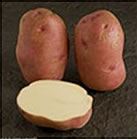 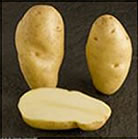 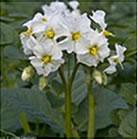 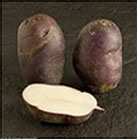
^ Spud-U-Like
Sarpo Una (left), Kifli (below left) and Blue Danube (below right) are three of the seven types of potatoes bred in North Wales for their hardiness, flavour, blight and virus resistance
You would think that a charity that’s a fine example of British plant science success and an unmistakeably positive horticultural ‘good news’ story would be sufficiently funded to continue its work in expanding seed potato supplies, but sadly this isn’t the case.
Today the Sarvari Research Trust lives very much a ‘hand-to-mouth existence’ from one small grant to another. Whilst this isn’t so different from the way many charities operate today, for the small team dedicated to developing this humble Hungarian potato, the Sarvari Research Trust is now having to consider all options relating to its future.
Dr Shaw recognises the bind that the Trust is currently in: “Our potatoes are a runaway success with allotment holders, private growers and a number of farmers who are working with us, but the larger commercial growers don’t seem to want to use our potatoes. Perhaps a groundswell of support from the bottom up could help to change the situation.”
www.sarvari-trust.org
Making An Entrance
I recently designed and planted up a new raised bed in the main entrance area of a local caravan park, Garreg Goch, at Morfa Bychan, on the coast near Porthmadog.
The new bed is part of a range of improvements at the park undertaken by the owners and with input from a local architect and planning officials.
The bed has now been planted up with a centrepiece of three Trachycarpus fortunei (Chusan Fan Palms) and five different Phormiums (New Zealand / Mountain Flax). The plants were ordered from Larch Cottage Nursery.
Two bed designs were proposed and my clients opted for the ‘cloud’ shaped one. Local contractors, RP Jones, then built a palisade edging from 75mm round posts, sloping from 600mm at the rear to 150mm at the front. New top soil was brought in to deepen the soil available for the plants as the existing soil depth is 120mm (4”) then straight onto sand. www.garreggochpark.co.uk
www.larchcottage.co.uk

^ Without A Hitch
Five different Phormiums: P. cookianum subsp. Hookeri ‘Tricolor’, P. ‘Yellow Wave’, P. ‘Sundowner’, P. cookianum ‘Flamingo’ and P. ‘Jester’ and three Trachycarpus fortunei fill the new ‘cloud bed’ at the entrance to a caravan park in Morfa Bychan
Picture This…
Vicki Jordan, a Winchester-based Landscape Architect, is a keen botanist and all-round avid plant spotter. She has a wide selection of well-thumbed wildflower identification books to dip in and out of. Keen to add to my own collection, I asked her to list her ‘top three’ texts:
“A classic, The Concise British Flora in Colour by W. Keble Martin, can be picked up on Amazon for less than the postage. Published in 1965 by Ebury Press. I was given my copy by a kind and aware friend for my 21st birthday. Quite the best gift I have received and has been in constant use for over 40 years. This is a lovely book to capture the interest of children.
“Wild Flowers of Britain and Northern Europe. Published in 2003 by Cassell. The turn of each page is a joy and the margin drawings of identification details by Marjorie Blamey are exquisite. A fireside book for a winter evening; too beautiful to be rained upon and too large to be stuffed into a pocket.
“The Wild Flower Key by Francis Rose. This book relies equally on the abbreviated text and the pictures, although the latter are very accurate. Once you have the Genera, careful reading of the text and use of a hand lens will guide you to the species.”
I’ll leave the final word on plant identification to Vicki: “Whatever you do, get yourself a hand lens if you want to identify the species as well as the Genera. Then begin to understand the differences between the Families: the basic ‘what to look for’.”
Cuttings…
Healthy Body, Healthy Mind…
German scientists have established a link between keeping the mind active and postponement in cognitive decline in people with dementia. A combination of spiritual, physical and problem-solving exercises for two hours a day over a one year period, without medication, was found to postpone the progress of dementia by up to a year. Patients in the study were found to be twice as good at performing daily tasks as those treated with cholinesterase inhibitors.
Source: The i, Thursday 1st December 2011
Hard Graft…
Guerrilla Gardeners in San Francisco have come up with an ingenious way to produce fruit that’s easily available for the city’s hungry residents. They are grafting fruiting stems onto otherwise non-fruiting ornamental trees lining the city’s streets thereby using an existing resource. This propagation method is cheaper, quicker and (eventually) accessible to any passer by on the streets. “We have tens of thousands of trees in San Francisco. That’s a huge resource we could tap into to provide food for hungry people,” commented a GG member.
www.faircompanies.com/videos/view/guerrilla-grafters-adding-fruit-to-city-trees/
Pale Snail
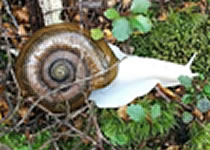 Reports of increasing albinism (white pigmentation) in the natural world include an extremely rare account of a white snail photographed in New Zealand late last year. Reports of increasing albinism (white pigmentation) in the natural world include an extremely rare account of a white snail photographed in New Zealand late last year.
www.treehugger.com/natural-sciences/rare-albino-snail-photographed-new-zealand.html
Head for Herbs…
I’m a volunteer with the local sustainability group in Gwynedd and as part of the upcoming Urdd Eisteddfod (the annual national cultural festival for youth), we are going to show visitors an imaginative way to re-use plastic milk containers.
If you’d like to give a new lease of life to your milk containers, you could turn them into handy, herby-head pots! There’s a guide sheet in the ‘step-by-step’ section on my website and you can also find out more about the Urdd Festival at:
www.urdd.org/eisteddfod
 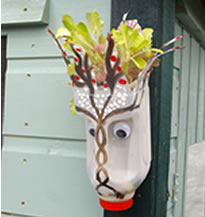 < Pot Head < Pot Head
Old milk containers, turned upside down, make excellent plant pots
Mark Rendell
gardener and garden designer
____________________________________________________________
Imaginative and affordable design
and planting schemes for every kind of garden
www.thegrowingcompany.co.uk
t: 01766 530824 m: 07780 920653
|

